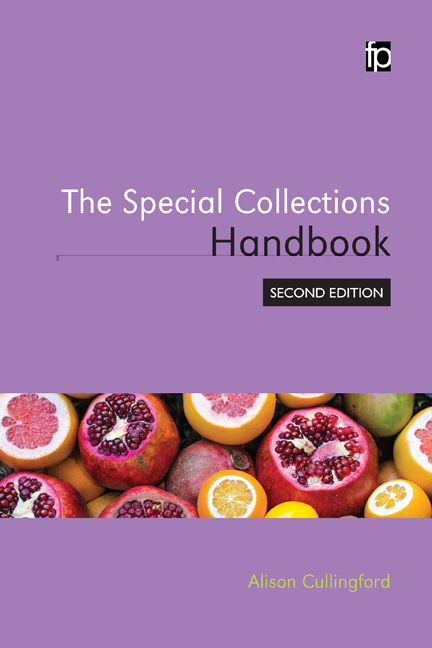Book contents
- Frontmatter
- Contents
- Preface and acknowledgements
- Introduction
- 1 The care of Special Collections
- 2 Emergency planning for Special Collections
- 3 Understanding objects in Special Collections
- 4 Acquiring and developing Special Collections
- 5 Cataloguing, description and metadata in Special Collections
- 6 Digitization and digital libraries in Special Collections
- 7 Legal and ethical issues in Special Collections
- 8 User services in Special Collections
- 9 Marketing and communications in Special Collections
- 10 Widening access to Special Collections
- 11 Organizational resources for Special Collections: space and people
- 12 Influencing and fund-raising for Special Collections
- Afterword: Special Collections futures
- Appendix A The Special Collections reference shelf
- Appendix B Skills for your Special Collections career
- Bibliography
- Index
2 - Emergency planning for Special Collections
- Frontmatter
- Contents
- Preface and acknowledgements
- Introduction
- 1 The care of Special Collections
- 2 Emergency planning for Special Collections
- 3 Understanding objects in Special Collections
- 4 Acquiring and developing Special Collections
- 5 Cataloguing, description and metadata in Special Collections
- 6 Digitization and digital libraries in Special Collections
- 7 Legal and ethical issues in Special Collections
- 8 User services in Special Collections
- 9 Marketing and communications in Special Collections
- 10 Widening access to Special Collections
- 11 Organizational resources for Special Collections: space and people
- 12 Influencing and fund-raising for Special Collections
- Afterword: Special Collections futures
- Appendix A The Special Collections reference shelf
- Appendix B Skills for your Special Collections career
- Bibliography
- Index
Summary
Introduction
The threats to Special Collections outlined in Chapter 1 harm collections over a period of years. This chapter discusses threats that can destroy collections or items within them very quickly: the timescale for effective action is much shorter, so prevention, planning and rapid response are essential. The chapter will cover:
Causes and impact of emergencies in Special Collections, with particular emphasis on fire and water damage.
How to prevent and prepare for emergencies via the emergency plan.
Issues in responding to and recovering from emergencies.
Planning for service continuity.
Security issues and how to manage them.
Insurance issues.
A note on terminology
An emergency is ‘any incident which threatens human safety and/or damages or threatens to damage (or destroy) an institution's buildings, collections, contents, facilities or services’ (Matthews and Eden, 1996, cited by Matthews, Smith and Knowles, 2009). Emergency planning seeks to prevent such incidents or to minimize their impact when they occur.
The term ‘disaster’ has traditionally been used by librarians to describe such events. It is not widely used in other professional areas, and ‘avoidance of the word “disaster” is seen as more positive’ (Dadson, 2012). The terms crisis or incident may also be encountered.
Emergency planning also needs to consider how to get the service back to normal as quickly as possible. This is known as service continuity or business continuity planning. The US government uses the term continuity of operations (COOP).
Understanding Special Collections emergencies
Special Collections are at risk from emergencies that may harm collections, affect services, and put human life and welfare in danger. Incidents are caused by various phenomena, including:
Extreme weather conditions: heavy rainfall or other precipitation, hurricanes or tornadoes, resulting in floods or destruction/damage of buildings.
Geological phenomena such as earthquakes, which impact on the building and its infrastructure.
Buildings and facilities problems such as electrical fires, leaking roofs and pipes.
Accidental damage, for example, fire started by discarded matches or cigarettes.
Arson and other criminal damage.
Accidental and deliberate incidents caused by people are also discussed under security, below. Serious mould outbreaks or pest infestations (see Chapter 1) may merit treatment as emergencies.
- Type
- Chapter
- Information
- The Special Collections Handbook , pp. 25 - 46Publisher: FacetPrint publication year: 2016



